The global sublimation paper market is projected to grow from USD 723.8 million in 2025 to USD 1,224.6 million by 2035, expanding at a compound annual growth rate (CAGR) of 5.4% during the forecast period. This growth is primarily driven by increasing demand for sublimation printing applications, rising adoption of customized products, and advancements in digital printing technologies.
Sublimation paper is widely used in printing high-quality images on various substrates, including textiles, ceramics, metals, and plastic items, making it an essential component in the custom printing and textile industries.
Sublimation printing, known for its ability to produce vibrant, durable, and long-lasting prints, is experiencing increasing popularity in various sectors, including fashion, sports, advertising, and home décor. The growing trend of personalized products, such as custom apparel, gifts, and promotional items, is significantly contributing to the market's expansion. The ease of use and the superior quality of sublimation prints compared to traditional printing methods further boost demand.
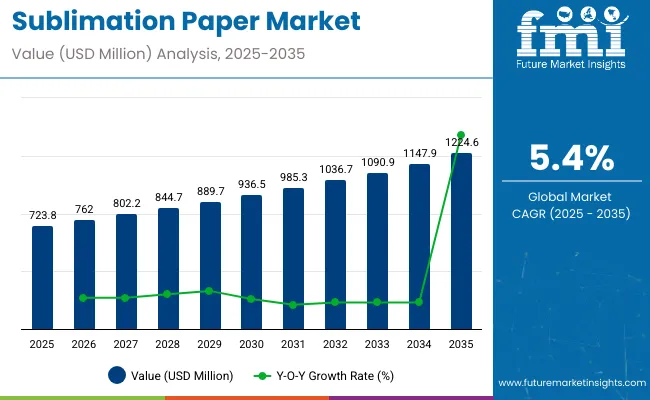
Technological advancements in sublimation paper, such as improved coatings for enhanced ink absorption and better print durability, are driving innovation in the market. Additionally, the increasing availability of eco-friendly and recyclable sublimation paper options is gaining attention, as environmental concerns become more prominent among consumers and businesses alike.
The Asia Pacific region is expected to experience the fastest growth due to rapid industrialization, rising demand for custom printing in the textile and promotional goods sectors, and the presence of major manufacturing hubs in countries like China and India. North America and Europe are expected to remain significant markets, with strong demand from the apparel and promotional industries.
In a 2023 industry interview, Ford Bowers, President and CEO of the Printing United Alliance, highlighted the industry's pivotal moment: “The printing industry stands at a critical juncture, and the manner in which it addresses these challenges will determine its trajectory for decades to come.” This statement underscores the importance of embracing technological advancements and sustainable practices to shape the future of printing.
As the demand for customized products continues to rise, the sublimation paper market is poised for steady growth through 2035.
The sublimation paper market is regulated to ensure product safety, environmental compliance, and compatibility with downstream applications in textiles, ceramics, and industrial printing. These regulations are critical for quality assurance, waste reduction, and adherence to environmental standards.
The sublimation paper market is globally integrated, with trade flows influenced by demand from the textile, sportswear, home décor, and promotional product industries. Trade is driven by quality standards, production capacity, and regional printing industry growth.
The below table presents the expected CAGR for the global sublimation paper market over several semi-annual periods spanning from 2024 to 2034.
| Particular | Value CAGR |
|---|---|
| H1(2024to 2034) | 5.3% |
| H2(2024to 2034) | 5.5% |
| H1(2025 to 2035) | 4.4% |
| H2(2025 to 2035) | 6.4% |
In the first half (H1) of the decade from 2024 to 2034, the business is predicted to surge at a CAGR of 5.3%, followed by a slightly higher growth rate of 5.5% in the second half (H2) of the same decade.
Moving into the subsequent period, from H1 2025 to H2 2035, the CAGR is projected to decrease slightly to 4.4% in the first half and remain relatively moderate at 6.4% in the second half. In the first half (H1) the market witnessed a decrease of 90 BPS while in the second half (H2), the market witnessed an increase of 90 BPS.
Fast-drying sublimation paper leads the market with a 41% share in 2025, driven by its efficiency and high-quality results. Paper-based sublimation materials dominate with a 52% share, reflecting the growing emphasis on sustainability and eco-friendly materials in the printing industry.
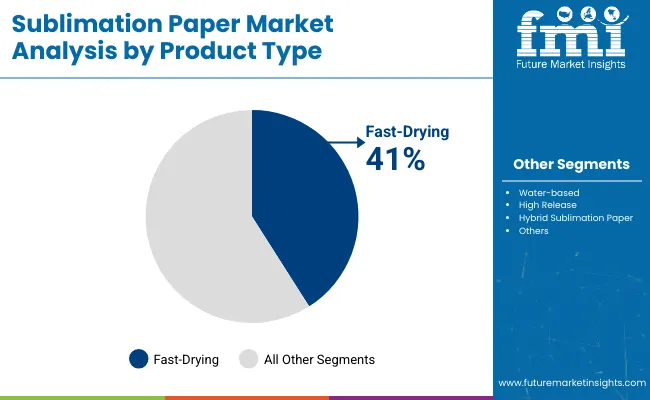
Fast-drying sublimation paper is expected to capture a 41% market share in 2025, driven by its superior performance and efficiency in the printing process. The fast-drying feature is crucial for high-speed printing operations, ensuring that the paper absorbs sublimation inks rapidly and transfers the image onto substrates with minimal drying time. This reduction in drying time boosts overall productivity and efficiency, making fast-drying sublimation paper highly preferred by commercial printers and manufacturers.
The growing demand for high-quality prints in various industries, such as textiles, promotional products, and personalized merchandise, contributes significantly to the demand for fast-drying sublimation paper. Additionally, advancements in ink formulations and printing technology have further enhanced the performance of these papers, ensuring vibrant, long-lasting colors and sharp image details. As the demand for faster and more efficient printing solutions continues to rise, the fast-drying sublimation paper segment is poised to expand, driving growth in the overall sublimation paper market through 2035.
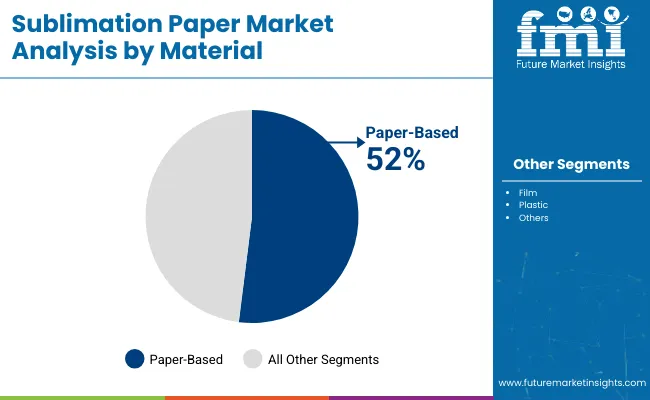
Paper-based sublimation materials are projected to dominate the sublimation paper market with a 52% share in 2025, driven by growing sustainability trends. As environmental awareness increases, paper-based sublimation materials are gaining popularity due to their renewable nature and biodegradability compared to synthetic alternatives. These materials provide a more eco-friendly option for businesses looking to reduce their environmental footprint while still achieving high-quality sublimation printing results.
The use of paper-based sublimation materials is particularly prominent in industries focused on sustainable practices, such as textile printing and custom merchandise. These materials offer excellent ink absorption, color vibrancy, and sharp image transfer, making them ideal for a wide range of applications, including sportswear, promotional products, and home décor.
As businesses prioritize eco-friendly solutions, the demand for paper-based sublimation materials is expected to increase, further consolidating their dominant position in the market. With innovations in sustainable paper technology and continued consumer demand for environmentally-conscious products, paper-based sublimation materials will continue to lead the market, driving growth in the sublimation paper industry through 2035.
Sublimation printing has become more popular among custom clothing, sportswear, and fashion wear because of the colorful color palette, long-lasting life, and high definition offered by this printing process. E-commerce and increased demand for personalization have encouraged most apparel companies and individual designers to turn towards sublimation printing, designing customized patterns and small-product items.
Furthermore, sublimation printing is also favored in green printing methods owing to least wastage and no use of strong chemicals. Increased acceptance of polyester-based fibers in sportswear and active wear is also an important driver propelling the demand for superior-quality sublimation paper.
Since the fashion market today leads the way with rapid production cycles along with sustainability, the sublimation paper market is predicted to expand unobstructed around the world with a specific interest in developing economies with increasing textile output.
Trendy styles falling under sublimation gift are one of the principal factors pushing the market for sublimation paper. Sublimation printing presents business and consumer markets with quality personalized printing on diverse ranges of products, including mugs and phone cases to frames and home decorations.
The online marketplaces offer Etsy, Redbubble, Printful, etc., where small businesses and entrepreneurs offer print-on-demand, thereby reducing their inventory costs and enabling them to use creative designs on their products. Sublimation printing has also seen growing demand for personalization by corporate gifts and promotions as companies seek to economically print their marketing materials and logos onto different surfaces.
The tourism industry has its share because sublimated souvenirs, such as printed t-shirts, keychains, and caps, are in high demand. The higher the sublimation printer becomes in terms of speed and cost, the higher the sublimation paper market experiences global growth.
The polyester-based items create a limitation since sublimation paper unfortunately is compatible only with polyester and polymer material coatings. Sublimation printing unlike other printing methods is not compatible with cotton or wool or any other natural fiber; therefore, use on synthetic materials and coated surfaces is limited.
Since more consumers are moving towards organic textiles, heavy reliance on polyester products will be a market constraint. Conversely, the manufacturing of polyester creates environmental issues like micro plastic contamination and excessive energy usage, prompting some producers to seek alternative printing processes.
Where this involves green coatings and hybrid print techniques, this market restriction is aggravated by the fact that no true cotton-compatible sublimation products exist. Until a technology breakthrough makes compatibility with natural fibers feasible, penetration of sublimation papers in the market may be prevented by some countries' tight environmental protection measures.
Tier 1 companies comprise market leaders capturing significant market share in sublimation paper market. These market leaders are characterized by high production capacity and a wide product portfolio. These market leaders are distinguished by their extensive expertise in manufacturing across multiple packaging formats and a broad geographical reach, underpinned by a robust consumer base.
They provide a wide range of series including recycling and manufacturing utilizing the latest technology and meeting the regulatory standards providing the highest quality. Prominent companies within tier 1 includeSappi Limited, Felix Schoeller, Hansol Paper., Ltd., Mitsubishi Paper Mills, Ltd., Ahlstrom Oyj.
Tier 2 companies include mid-size players having presence in specific regions and highly influencing the local market. These are characterized by a strong presence overseas and strong market knowledge. These market players have good technology and ensure regulatory compliance but may not have advanced technology and wide global reach.
Prominent companies in tier 2 includeBeaver Paper & Graphic Media Inc., Seiko Epson Corporation, Neenah Coldenhove, Hanrun Paper, Contrado Imaging Ltd, Beaver Paper & Graphic Media Inc. (Koehler Group), Coldenhove Holding B.V.
Tier 3 includes the majority of small-scale companies operating at the local presence and serving niche markets. These companies are notably oriented towards fulfilling local market demands and are consequently classified within the tier 3 share segment.
They are small-scale players and have limited geographical reach.Tier 3, within this context, is recognized as an unorganized market, denoting a sector characterized by a lack of extensive structure and formalization when compared to organized competitors.
The section below covers the future forecast for the sublimation paper marketin terms of countries. Information on key countries in several parts of the globe, including North America, Latin America, East Asia, South Asia and Pacific, Western Europe, Eastern Europe and MEA is provided. USA is expected to account for a CAGR of 4.3% through 2035. In Europe, Spainis projected to witness a CAGR of 5% by 2035.
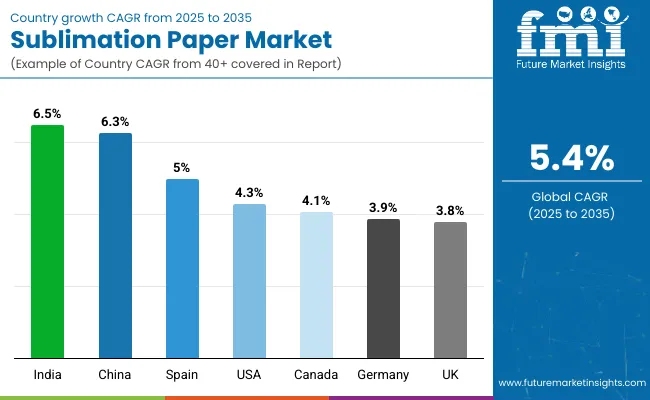
| Country | Value CAGR (2025 to 2035) |
|---|---|
| USA | 4.3% |
| Germany | 3.9% |
| China | 6.3% |
| UK | 3.8% |
| Spain | 5.0% |
| India | 6.5% |
| Canada | 4.1% |
Within the United States, the development of small and medium enterprises and print-on-demand operations is a major driving force for the sublimation paper industry. Independent artists and entrepreneurs utilize personal printing websites such as Printful, Teespring, and Zazzle for bespoke printing to create bespoke clothing, accessories, and home accessories without inventory.
Therefore, with the gig economy on the rise and a growing demand for personalized products, there has been a greater need for sublimation printing solutions in terms of cheap print solutions with high-quality colors and durability.
Also, the growth of small-scale printing shops and local customization outlets has increased the demand for high-quality sublimation paper. As customers seek distinctive, personalized products, particularly for presents, branding, and personal needs, the American market for sublimation paper will continue to gain. Easy access to digital design and online shopping further stimulate this trend, making sublimation printing the go-to for startups and creatives.
The German sublimation paper market has its supporters in sustainable and high-quality printing solutions. As one of Europe's major printing and textile production centers, it strongly supports green and long-lasting printing modes. There is growing demand for high-performing sublimation paper as companies look for low waste and chemical-free substitutes for traditional printing.
Bonus points for no water pollution in sublimation printing-pull for German firms with an environmental conscience. Sportswear and automotive industries are embracing sublimation printing for long-lasting fade-resistant prints on uniforms, car interiors, and promotional materials.
With their strong stand on chemicals employed in printing and increased focus on eco-friendly textile production, these German firms are placing investments in innovative sublimation paper technologies that will deliver top-quality prints with little environmental footprint. This trend, in turn, will fuel market growth as companies begin trending toward environmentally friendly printing solutions.
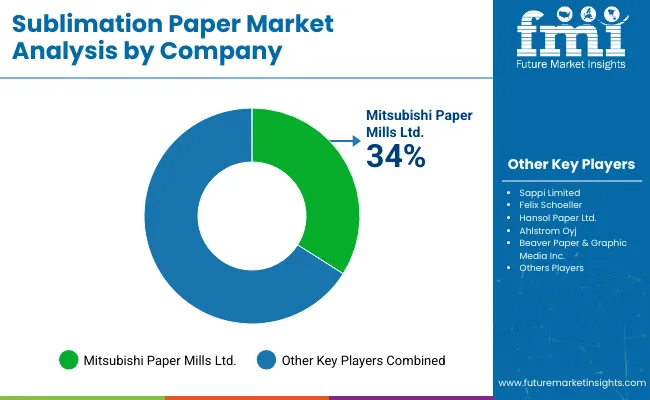
The sublimation paper market is highly competitive, with a mix of global manufacturers, regional players, and niche specialists. Leading companies such as Sappi Limited, Felix Schoeller, Hansol Paper, Mitsubishi Paper Mills, and Ahlstrom dominate the market through strong production capabilities, broad product offerings, and global reach.
Mid-sized firms like Beaver Paper, Neenah Coldenhove, Hanrun Paper, and Seiko Epson hold significant regional influence by focusing on quality and application-specific solutions. Smaller companies serve niche segments including textiles, ceramics, and promotional goods.
Competition in the market is driven by advancements in coating technology, improved color transfer, eco-friendly raw materials, and compatibility with high-speed printers. Strategic partnerships and continuous innovation are key factors enabling companies to strengthen their market position.
| Report Attributes | Details |
|---|---|
| Market Size (2025) | USD 723.8 million |
| Projected Market Size (2035) | USD 1,224.6 million |
| CAGR (2025 to 2035) | 5.4% |
| Base Year for Estimation | 2024 |
| Historical Period | 2020 to 2024 |
| Projections Period | 2025 to 2035 |
| Quantitative Units | USD million for value and metric tons for volume |
| Product Types Analyzed (Segment 1) | Tacky, Fast Drying, Water-Based, High Release, Hybrid Sublimation Paper |
| Material Types Analyzed (Segment 2) | Film, Plastic, Paper |
| Paper Types Analyzed (Segment 3) | Coated, Uncoated Sublimation Paper |
| Applications Analyzed (Segment 4) | Fashion, Textiles & Apparel, Fashion Accessories, Sportswear, Sports Uniforms, Sports Accessories, Soft Signage & Banners, Home Textiles & Décor, Ceramics & Metal Products, Other Industries |
| Regions Covered | North America; Latin America; East Asia; South Asia & Pacific; Western Europe; Eastern Europe; Middle East & Africa |
| Countries Covered | United States, Canada, Brazil, Mexico, Germany, France, United Kingdom, Italy, Spain, China, Japan, South Korea, India, Australia, UAE, South Africa |
| Key Players Influencing the Market | Sappi Limited, Felix Schoeller, Hansol Paper Ltd., Mitsubishi Paper Mills Ltd., Ahlstrom Oyj, Beaver Paper & Graphic Media Inc., Seiko Epson Corporation, Neenah Coldenhove, Hanrun Paper, Contrado Imaging Ltd. |
| Additional Attributes | Market size and dollar sales data; Competitor market shares; Regional demand trends; Substrate preferences; Growth opportunities in textile and promotional markets |
The market is segmented into tacky, fast drying, water-based, high release, and hybrid sublimation paper.
Sublimation paper is categorized based on material type into film, plastic, and paper.
The segmentation by paper type includes coated and uncoated sublimation paper.
Sublimation paper is widely used in various applications, including fashion, textiles & apparel, fashion accessories, sportswear, sports uniforms, sports accessories, soft signage & banners, home textiles & décor, ceramics & metal products, and other industries.
Key Countries of North America, Latin America, East Asia, South Asia & Pacific, Western Europe, Eastern Europe and Middle East & Africa are covered.
The sublimation paper market is projected to witness CAGR of 5.4% between 2025 and 2035.
The sublimation paper market stood at 686.7 million in 2024.
Sublimation paper market is anticipated to reach USD 1,224.6 million by 2035 end.
East Asia is set to record a CAGR of 6.5% in assessment period.
The key players operating in the sublimation paper market include Sappi Limited, Felix Schoeller, Hansol Paper., Ltd., Mitsubishi Paper Mills, Ltd., Ahlstrom Oyj.
Table 01: Global Market Volume Analysis (million M.Sq.Mt) 2019 to 2023 and Forecast 2024 to 2034, By Product Type
Table 02: Global Market Value (US$ million) 2019 to 2023 and Forecast 2024 to 2034, By Product Type
Table 03: Global Market Volume Analysis (million M.Sq.Mt) 2019 to 2023 and Forecast 2024 to 2034, By Material
Table 04: Global Market Value Analysis (US$ million) 2019 to 2023 and Forecast 2024 to 2034, By Material
Table 05: Global Market Volume (million M.Sq.Mt) 2019 to 2023 and Forecast 2024 to 2034, By Paper Type
Table 06: Global Market Value (US$ million) 2019 to 2023 and Forecast 2024 to 2034, By Paper Type
Table 07: Global Market Volume Analysis (million M.Sq.Mt) 2019 to 2023 and Forecast 2024 to 2034, By Application
Table 08: Global Market Value Analysis (US$ million) 2019 to 2023 and Forecast 2024 to 2034, By Application
Table 09: Global Market Volume Analysis (million M.Sq.Mt) 2019 to 2023 and Forecast 2024 to 2034, By Region
Table 10: Global Market Value Analysis (US$ million) 2019 to 2023 and Forecast 2024 to 2034, By Region
Figure 01: Global Market Share Analysis by Product Type 2024E to 2034F
Figure 02: Global Market Share Analysis by Region 2024E
Figure 03: Global Market Share Analysis by Application 2024E to 2034F
Figure 04: North America Market Share Analysis by Product Type 2024E to 2034F
Figure 05: North America Market Share Analysis by Country 2024E
Figure 06: North America Market Share Analysis by Application 2024E to 2034F
Figure 07: Latin America Market Share Analysis by Product Type 2024E to 2034F
Figure 08: Latin America Market Share Analysis by Country 2024E
Figure 09: Latin America Market Share Analysis by Application 2024E to 2034F
Figure 10: Western Europe Market Share Analysis by Product Type 2024E to 2034F
Figure 11: Western Europe Market Share Analysis by Country 2024E
Figure 12: Western Europe Market Share Analysis by Application 2024E to 2034F
Figure 13: Eastern Europe Market Share Analysis by Product Type 2024E to 2034F
Figure 14: Eastern Europe Market Share Analysis by Country 2024E
Figure 15: Eastern Europe Market Share Analysis by Application 2024E to 2034F
Figure 16: East Asia Market Share Analysis by Product Type 2024E to 2034F
Figure 17: East Asia Market Share Analysis by Country 2024E
Figure 18: East Asia Market Share Analysis by Application 2024E to 2034F
Figure 19: South Asia Market Share Analysis by Product Type 2024E to 2034F
Figure 20: South Asia Market Share Analysis by Country 2024E
Figure 21: South Asia Market Share Analysis by Application 2024E to 2034F
Figure 22: Middle East & Africa Market Share Analysis by Product Type 2024E to 2034F
Figure 23: Middle East & Africa Market Share Analysis by Country 2024E
Figure 24: Middle East & Africa Market Share Analysis by Application 2024E to 2034F






Full Research Suite comprises of:
Market outlook & trends analysis
Interviews & case studies
Strategic recommendations
Vendor profiles & capabilities analysis
5-year forecasts
8 regions and 60+ country-level data splits
Market segment data splits
12 months of continuous data updates
DELIVERED AS:
PDF EXCEL ONLINE
Market Share Breakdown of Sublimation Paper Manufacturers
Dye-Sublimation Printing Machines Market
Paper Wrap Market Size and Share Forecast Outlook 2025 to 2035
Paper Cups Market Size and Share Forecast Outlook 2025 to 2035
Paper Core Market Size and Share Forecast Outlook 2025 to 2035
Paper Bags Market Size and Share Forecast Outlook 2025 to 2035
Paper Processing Resins Market Size and Share Forecast Outlook 2025 to 2035
Paper Tester Market Size and Share Forecast Outlook 2025 to 2035
Paper Napkin Converting Lines Market Size and Share Forecast Outlook 2025 to 2035
Paper Packaging Tapes Market Size and Share Forecast Outlook 2025 to 2035
Paper Napkins Converting Machines Market Size and Share Forecast Outlook 2025 to 2035
Paper Coating Binders Market Size and Share Forecast Outlook 2025 to 2035
Paper Core Cutting Machine Market Size and Share Forecast Outlook 2025 to 2035
Paper Recycling Market Size and Share Forecast Outlook 2025 to 2035
Paper Release Liners Market Size and Share Forecast Outlook 2025 to 2035
Paper Coating Materials Market Size and Share Forecast Outlook 2025 to 2035
Paper Pigments Market Size and Share Forecast Outlook 2025 to 2035
Paper Honeycomb Market Size and Share Forecast Outlook 2025 to 2035
Paper Edge Protector Market Analysis - Size, Share, and Forecast Outlook for 2025 to 2035
Paper Cup Lids Market Analysis - Size, Share, and Forecast Outlook for 2025 to 2035

Thank you!
You will receive an email from our Business Development Manager. Please be sure to check your SPAM/JUNK folder too.
Chat With
MaRIA